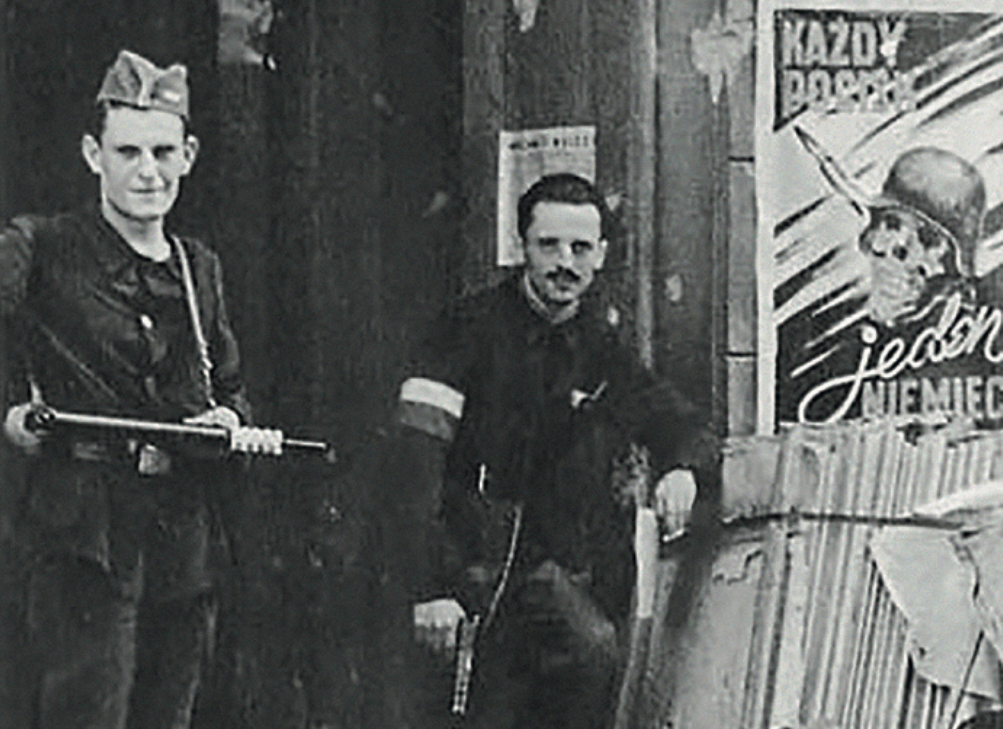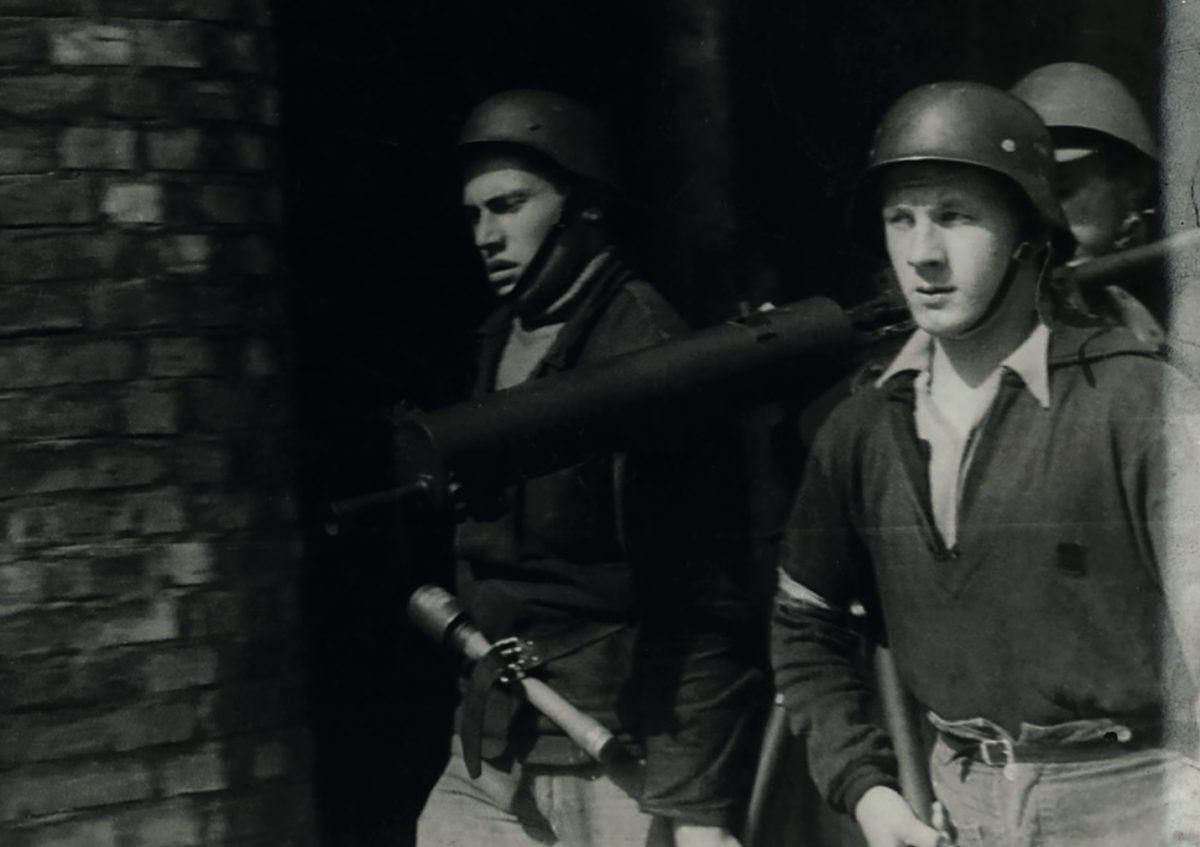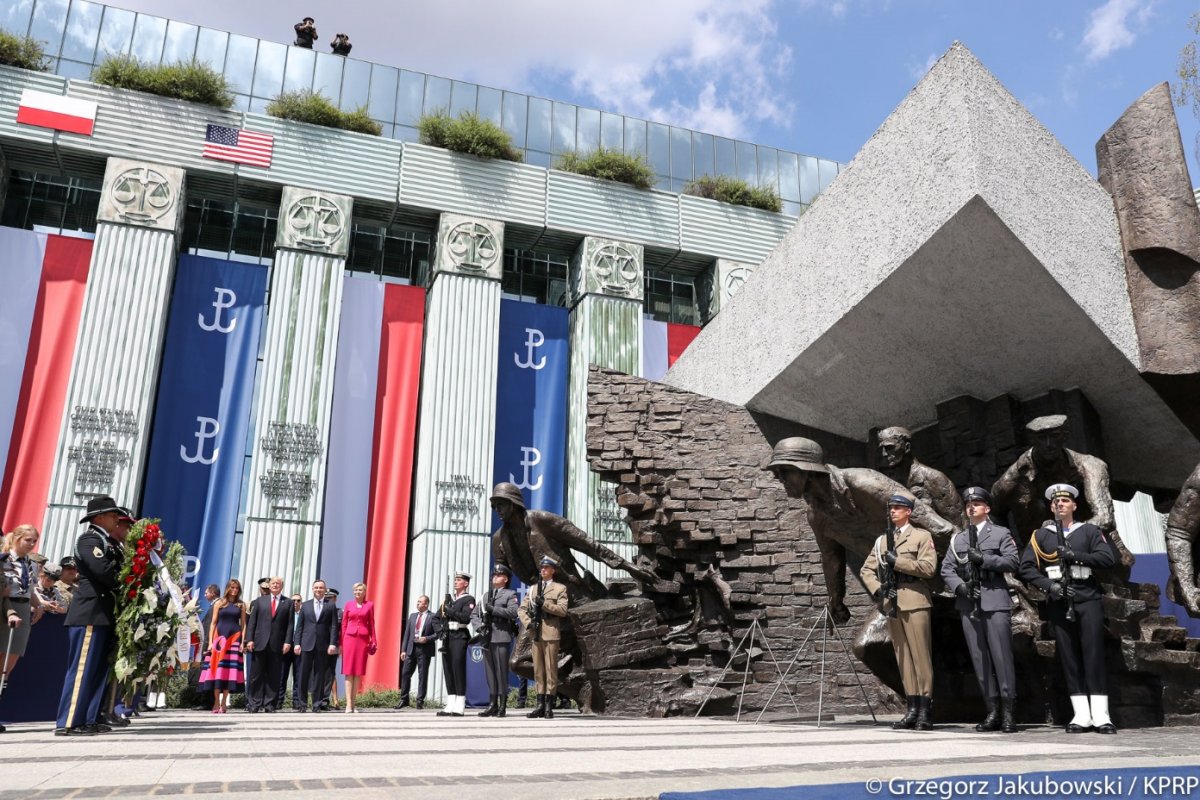Others claim that given the military and political situation of the time, there was no other option than to try and retake Warsaw and win back the independence for the Homeland.
Years go by and the discussion on the point of the Uprising continues. For some, the anniversary of its outbreak is another chance for bowing before the graves of the Polish heroes and honour their memory. For others, it is an opportunity to try and prove the futile and false thesis that the insurgents from the Home Army and National Armed Forces “massacred” Jews – the survivors from the Warsaw ghetto. For some it is a pretext for having their few seconds in media.
Today, it is easy to throw around negative assessments, knowing the final result of Poles’ decision to fight, the political situation of the time and the details of the often changing Warsaw front. It is true – the Warsaw Uprising fell. It broke down militarily. It ended in surrender and failed to realise its political goals, while the country succumbed to decades of Soviet and communist slavery. But we only know it now. What Poles could have known about the outcome of their fight as they were preparing it in July 1944? I am curious as to how they predicted the future when they had to face two totalitarian regimes in September 1939. What were the perspectives of the conspirators who massively volunteered for the Polish underground army, knowing at the same time that the underground resistance would lead to an armed uprising against the occupant?
Towards the uprising
The first mention of the future general uprising appeared in the instructions of gen. Kazimierz Sosnkowski to col. Stefan Rowecki in December 1939 regarding the founding of the Union of Armed Struggle. The Polish plans for insurgency were accepted by Poland’s western allies. The British even promised extensive help from air and to drop Polish paratroopers.
The concept of an uprising evolved over the course of several years in Poland, in the end taking the form of operation “Tempest”. It was to be based on local fighting against the German troops, cooperation with the approaching Red Army, revealing the underground structures to the Soviets and organising civilian authorities at the freed territories. Even though, in 1943 the USSR – as a result of the discovery of the Katyń Massacre – broke diplomatic relations with the Polish government-in-exile in London, Poles hedged their bets on the cooperation with the Soviets.

This decision seems entirely adequate to the situation, since the Red Army entered the lands of the Second Republic of Poland and was closing in to the Vistula river, beating the Germans along the way. Naturally, Poles did not forget September 17th 1939 and the then unexplained massacre in Katyń. However, the Soviet Union was “the ally of our allies”, the country where the Polish Army of gen. Władysław Anders, which was the salvation for thousands of Poles imprisoned in Soviet gulags, had been created. Hence, instead of another armed confrontation, Poles decided to try and cooperate with the powerful eastern neighbour.
Nonetheless, the meeting with Joseph Stalin’s army looked the same everywhere. After shared battles against the Germans, the Soviets promised Poles the creation of their own units and invited Home Army commanders for talks. Of course, no discussions took place – the officers were arrested, soldiers disarmed and a choice was given: to either serve in gen. Zygmunt Berling’s army, which was subordinate to the Soviets, or to be sent east to gulags. That is what happened i.e. in Vilnius and Lviv. Some representatives of the Polish elite silently hoped that everything would be better behind the Bug river. They could not have been more wrong. Following the shared liberation of Lublin, the Home Army soldiers were disarmed, arrested and locked in, among other places, the German camp in Majdanek which they had just freed. It was done similarly with the soldiers of the 27th Volhynia Home Army Infrantry Division in Kock and Lubartów.
Perhaps the representatives of the Polish government-in-exile and the Polish army staying in the British Isles, as well as the ones in the occupied country knew nothing concrete on the Tehran conference. At least that is what some of them claimed after the war. In the autumn of 1943, the United States, Great Britain and Soviet Union decided in Tehran – without the representatives of Poland present – that the eastern border of the Republic of Poland was to be moved to the line of the Bug river, the Polish Borderlands were to be handed to the Soviets, the entirety of Poland was to be under Red Army’s operational zone, while the future Soviet occupation zone of Germany was to be adjacent to Poland and all the communication routes between that one and the USSR were to be running through Poland. That is why, following the Tehran conference, the Soviets marched through Poland with such certainty and frivolity. By pacifying the Polish armed underground, at the same time they signalled to the world that these were criminal gangs cooperating with the Nazis, not a regular army. Today we know, that Stalin had no intention of sharing his power in Poland with the Home Army, the Polish government in London or any other independent structures of Poland. After all, he had his communist supporters in Poland from the Polish Workers’ Party, Union of Polish Patriots, the People’s Army and People’s Guard and the Polish Committee of National Liberation.
In the summer of 1944, there were no plans for the uprising operation in Warsaw. It all changed when gen. Leopold Okulicki codename “Niedźwiadek” came to the occupied capital and started convincing the officers of the General Command of the Home Army to the idea of a single battle for Warsaw. Besides, Poles could already hear the roars of the Soviet cannons and saw the columns of beaten and disorganised enemy troops retreating through the city. German officials working in Warsaw soon joined the demoralised escapees from the eastern front. The beginning of the last decade of July 1944 painted a picture of a German army beaten in the east and the interregnum in the city for the residents of Warsaw. Moreover, the information on the assassination attempt on Hitler, even though it was unsuccessful, reached the city. Under these circumstances, the decision was made to fight in the capital. The government of prime minister Stanisław Mikołajczyk gave the green light in the country, while the Supreme Commander gen. Sosnkowski, even though personally against the uprising, in his order from the beginning of July left it open to interpretation, by writing that if there was a possibility to:
“even temporarily get a hold of Vilnius, Lviv or other, large centre […] – it needs to be done in order to be seen as their rightful owners”.

By the end of July, the Germans managed to take control of the situation in Warsaw. Officials returned to the city and reinforcements approached the Vistula river, with the “Hermann Göring” division on the front. The armoured battle near Radzymin was coming to an end, but the Soviets managed to take, among others, Wołomin, Radzymin, Miłosna and many other towns, reaching as far as Praga, so the district on the right bank of Warsaw. One officer of the Home Army was riding on one of the tanks which reached the first buildings of the Praga district and immediately made a report on the situation on the other side of the river. This information became the pretext for the final decision on the start of the uprising in Warsaw. Despite the news from the west, provided by courier Jan Nowak-Jeziorański, that the allies would not be of much help and the lack of armament stressed by the officers of the General Command of the Home Army (even in July several hundred submachine guns had been sent to the eastern zones of the Home Army from Warsaw), the date of the beginning of the resistance actions was set for August 1st 1944, at 5 pm. The Home Army was in a hurry to liberate the city before the Soviet tanks would enter and the communists would reign their terror.
The annihilation of the city
At the “W” hour, the Home Army began its operation. During the first several days, it managed to take control of most of the city. Poles took, among other places, the power plant in Powiśle, for short the Wileński Railway Station and a camp at the Gęsia street, where around 350 Jews were freed. Unfortunately, the Germans kept virtually all strategically important points in Warsaw – including airfields and bridges. Even though, in the last days of July the communist radio “Kościuszko”, broadcasting from Moscow, encouraged the residents of Warsaw to start the uprising, now Stalin stopped the advance of his forces. Following the defeat in the armoured battle, despite the readiness of marshall Konstanty Rokossowski to begin offensive actions, the front on the suburbs of the capital froze for long weeks. The Red Army soldiers at the warecko-magnuszewski outpost and near Otwock also took defensive positions.
Cutting himself off of the “unreasonable, horrible fuss”, Stalin even categorically banned combat flights over the fighting Warsaw. Also the western allies, who two years ago promised to help the Polish uprising, now turned their backs on them. Their excuse for the lack of help were technical issues. Hence, they did not send paratroopers of gen. Stanisław Sosabowski to the Polish capital, and they limited the supply drops to the minimum. As the time passed and the German reinforcements entered the battlefield, the resistance of the insurgents, scattered and separated from each other in different districts of the city, was systematically broken. The very moment the Home Army commanders began negotiations for surrender, Stalin gave a fraction of help. The Soviets took the Praga district, planes with red stars appeared above Warsaw and the soldiers of the Berling army landed on the left bank of the river on a suicide mission. The whole operations was only meant to postpone the Polish surrender and prolong the fighting, which ended in a total defeat on October 2nd 1944.
The account of successes and losses of the Warsaw Uprising was catastrophic for Poles. Around 18 thousand insurgents and 150 thousand civilians lost their lives, while the entire city practically seized to exist, demolished by the German during the fighting and later burned to the ground on the mad order of Hitler. The insurgency in Warsaw was too costly for Poles and did not save the independent statehood of Poland after the Second World War. Even though, there was never even a shadow of Polish government collaborating with Hitler’s Third Reich, even though there were no Polish SS troops nor any “Polish death camps” – still, after the war, as the representatives of the Polish Underground State bitterly said, “we were treated worse than Hitler’s allies: Italy, Romania and Finland”. Admittedly, the democratic world admired Warsaw’s fight and felt sympathy for the insurgents, but in 1945 in Yalta and Potsdam it was the USSR which played all the cards, while the United States and Great Britain de facto agreed for another, Soviet occupation of Poland. The matter of Poland’s independence on the international scene died for decades.

Diamond of Polish history
Taking nothing but profits and losses into account, it is clear that it was not worth it for Poles to fight in August and September of 1944. But we only know the outcome now. Some historians believe that the uprising should not have been initiated. But then again, maybe Poland should have accepted Hitler’s offer from 1939 regarding Gdańsk and the extraterritorial corridor? In that case, the September of 1939 would not be so catastrophic for Poland. Maybe Poles should have succumbed to foreign acts of violence? There would be no battle of Grunwald, Vienna, national uprisings of the XIX century, the Miracle of the Vistula. After all, why should we fight for our own independence, the freedom of views? Of course, it is one way out of the situation – to find a foreign master and try to be the best servant for him. Perhaps, it is best to immediately surrender, as the Czechs did in the spring of 1939. After all, Prague was not demolished. However, if we are searching for analogies between Warsaw and Prague, then in the Czech capital, when the front approached it in May 1945, the anti-German uprising broke out as well. Maybe because it lasted very short (between May 5-9 1945) and the Red Army very quickly changed its operational plans and immediately supported the insurgents – not many remember it today. Similar fights broke out in August 1944 in Paris, but then the Americans and the French of gen. Charles de Gaulle fighting alongside them rushed to help the French resistance fighting in the city.
Today, we know how the Warsaw uprising ended. But who could have predicted that on July 31st or August 1st 1944? It would be reckless and suicidal to start the uprising in 1942 when the Germans were winning in all parts of Europe and the eastern front reached as far as Stalingrad and Caucasus. However, by the end of July 1944 the front was already at Warsaw. The Soviet armoured vehicles were several dozen kilometres away from the Warsaw bridges. The communist radio “Kościuszko” encouraged to fight and the soldiers of the voluntary underground army for so many years of the occupation were forced to watch the German brutality in the occupied capital, waiting impatiently for the moment of fighting, liberation and revenge. The time came on August 1st. It was the last chance to fight the hated enemy, while at the same time fighting – in a political sense – against the Soviet occupant, who had already been preparing new chains for Poland, for the free future of the Homeland.
The Warsaw Uprising is one of the most unique events in the history of Poland. It is the most beautiful battle of the Polish nation. Even by the Germans, the fighting at the Warsaw Old Town and the Czerniaków outpost were compared to the toughest battles fought during the Second World War, like the one in Stalingrad. The fight for freedom of 50 thousand soldiers of the volunteer army and the two months of struggle of the unruly city against the German occupant are incomparable to anything in the history of the Second World War. The mass German genocide (over the course of several days they murdered several dozen thousand civilian residents of the Wola district), the unbalanced forces, the means to fight used by the Polish underground, the German soldiers and their armed to the teeth collaborators, the unthinkable sacrifice of the insurgents and civilians and finally the Nazi annihilation of the already defeated city – all these characteristics make the historical event truly extraordinary.
For Poles, the Warsaw Uprising is a symbol which cannot be defiled and the city is a place which was made sacred with blood on almost every corner. It is the most beautiful diamond of our history and the authentic testimony of the Polish nation’s love for freedom.
“We wanted to be free and owe the freedom to ourselves” – wrote the Government Delegate for Poland and the deputy prime minister of the Polish government Jan Stanisław Jankowski codename “Soból”.
Although Poland stood against the two totalitarian powers from the very beginning of the global conflict, remained in the camp of the countries of the anti-Hitler coalition and was the most faithful ally to the Great Britain, it had to pay an enormous price for its will to be independent. Warsaw bled out, while the entire world, despite the words of compassion and solidarity, idly stood by and watched as the city slowly died. And then Poland could not avoid decades of communist slavery anyway.
Author: Szymon Nowak
The article comes from issue no. 7-8/2019 of the “Biuletyn IPN” and is also part of the English content section of the IPN's NextStopHistory website.